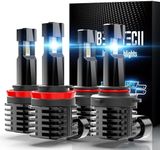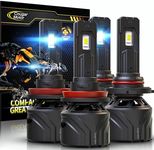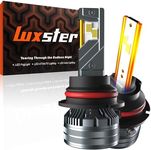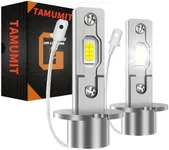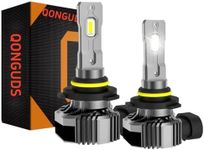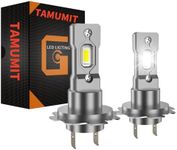Buying Guide for the Best Led Car Headlights
Choosing the right LED car headlights can significantly improve your driving experience, especially at night or in poor weather conditions. LED headlights are known for their brightness, energy efficiency, and long lifespan. When selecting LED headlights, it's important to consider several key specifications to ensure you get the best fit for your vehicle and driving needs.Brightness (Lumens)Brightness, measured in lumens, indicates how much light the headlight produces. This is important because brighter headlights can improve visibility, making it easier to see the road and any potential hazards. LED headlights typically range from 3,000 to 10,000 lumens. For city driving, lower lumens (around 3,000-5,000) may be sufficient, while for rural or poorly lit areas, higher lumens (6,000-10,000) are recommended.
Color Temperature (Kelvin)Color temperature, measured in Kelvin (K), describes the color of the light emitted by the headlights. This is important because different color temperatures can affect visibility and eye strain. LED headlights usually range from 3,000K to 6,500K. Lower temperatures (3,000K-4,000K) produce a warm, yellowish light, which is easier on the eyes but may not be as bright. Higher temperatures (5,000K-6,500K) produce a cool, white or bluish light, which is brighter and can improve visibility but may cause more glare.
Beam PatternThe beam pattern determines how the light is distributed on the road. This is important because a well-designed beam pattern can provide better visibility without blinding other drivers. There are two main types: reflector and projector. Reflector beams are more common and provide a wider spread of light, while projector beams offer a more focused and intense light. Choose a beam pattern that suits your driving conditions; wider beams are better for city driving, while focused beams are ideal for highway driving.
CompatibilityCompatibility refers to whether the LED headlights will fit and work with your vehicle. This is crucial because not all headlights are universal. Check your vehicle's manual or consult with a professional to ensure the headlights you choose are compatible with your car's make and model. This includes considering the bulb size and type (e.g., H4, H7) and ensuring the headlights can be properly installed.
LifespanLifespan indicates how long the LED headlights are expected to last. This is important because longer-lasting headlights mean fewer replacements and better value over time. LED headlights typically last between 30,000 to 50,000 hours. If you drive frequently or for long distances, opt for headlights with a longer lifespan to minimize maintenance.
Energy EfficiencyEnergy efficiency refers to how much power the headlights consume. This is important because more efficient headlights can reduce the load on your vehicle's electrical system and improve fuel efficiency. LED headlights are generally more energy-efficient than halogen or HID headlights. Look for headlights with lower wattage (e.g., 25-40 watts) that still provide adequate brightness.
Heat DissipationHeat dissipation is the ability of the headlights to manage and disperse heat. This is important because excessive heat can reduce the lifespan and performance of the headlights. LED headlights come with built-in cooling systems, such as fans or heat sinks. Choose headlights with effective heat dissipation features to ensure they operate efficiently and last longer.

